Rainbow Plateau | Mongollon Rim | Mexico's Copper Canyon | Europe | Canyons of Mars | Crystal Caves | Canyonland Books
The Tarahumara Racing Tribe of Copper
Canyon Mexico have long been famous as perhaps the finest ultra long distance
runners in human history. This was never proven until The Tarahumara Racing Team
entered the Leadville Trail 100 Race in 1993 and 1994 and the Angeles Crest
Trail 100 race in 1997. From the extensive race records compiled by the
Tarahumara 1993-1997 we can now know what the Anasazi, Apache, Aztec and Inca,
all historically famous runners, as well as many other
Native American tribes could easily have run the 100 mile distance at high
altitudes and over very rugged terrain in seventeen to twenty two (17-22) hours.
Even less talented, older, younger and women Indian runners could have
covered these distances in less than thirty (30) hours. This is now clearly
validated for the Tarahumara Racing Team historical record in the USA and the
1990's.
Richard D. Fisher, as the coach and sponsor said, "I believe from my in-depth experience spanning 2 decades with these Indian runners at the 100 mile distance, that fast times would be around 15-16 hours for the most elite prehistoric Indian tribal racers and messengers like the Inca, Aztec, Anasazi and Apache.
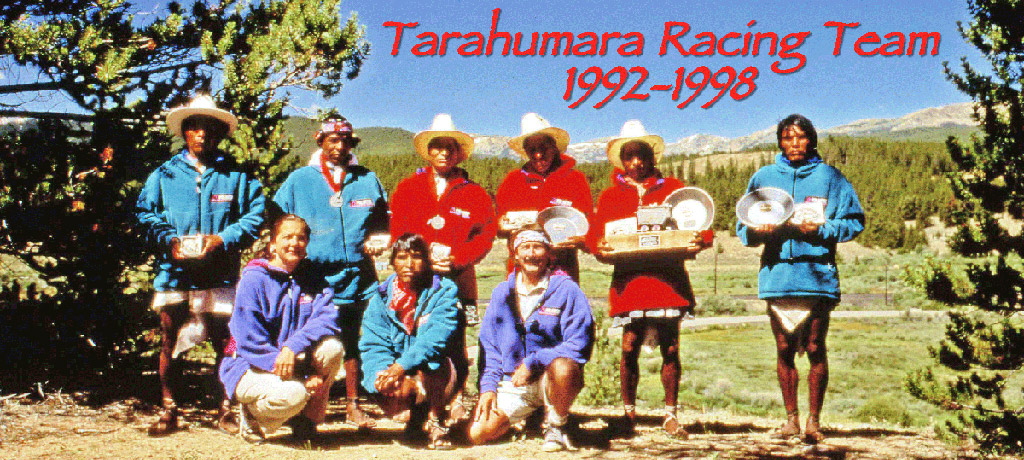
The Tarahumara Racing Team and sponsors Kit Williams and Richard D Fisher 1993
Archaeologist and Historians, you can bank on this information for your time and travel distance studies. This is documented scientific data, on the stop watch and on very well documented terrain, and is as good as it gets data.
At last now the fastest times were historically recorded at three races at Leadville Trail 100 in 1993 &1994 and the Angeles Crest 100 in 1997. While these fine Native American Racers had many adventures and mis-adventures, as might be expected, now historical records give us a very good idea of the ancient historically unrecorded Anasazi, Apache, Aztec and Inca running and distance travel abilities. As such, these Tarahumara Indian runners of 1993 - 1997 are an outstanding and lasting tribute to the Native American racers of recent times as well as Indian runners of old.
The History of Native American endurance running
1993 - 1997
The Leadville Trail 100 1993
The Leadville Trail 100 1994
1st place - 1994 Juan Herrera, 25, Tarahumara 17:30:42
Leadville was the venue for the USA debut of the Tarahumara runners of the Tarahumara Racing Team the first winning team ever organized for the tribe by thier coach and sponsor Richard D. Fisher. Tarahumara teams competed in the Leadville Trail 100 in 1993 and 1994 and won the event outright both years. In 1993, Victorian Churro a slender 55 year old came in first, followed by teammate Cerrildo Chacarito in second. Twenty five year old Juan Herrera won in record time of 17:30:42. His mark stood for 11 years. (Wikipedia corrected.)
As of 2013 the International Race Records Report the Tarahumara had the youngest as well as oldest winners in history of Ultra Running 100 mile races. The Tarahumara Racing Team also posted the youngest ever finisher.
This is a truly incredible record of Tarahumara racing prowess. Seven of the top 11 finishers. This show the American racing community that the Tarahumara were a real precieved threat to white domination. It is after this that many weird and dangerous things began t happen to the Indian runners out in the woods and in closed aid stations and also not being able to enter races officially. There were a few wins after 1994 but nothing like what coule have been. One must keep in mind that this was the first ever entry into a white mans race so they had no experience. If given the chance later they would have done even better. This was a true tragedy for many individual runners as the team really only had 2 chances at winning and they got virtually nothing for their efforts. The team sponsor Richard D. Fisher was the only one to pay cash rewards and tons of food to the villages of origin.
The Wasatch Front Trial 100
(not allowed to enter officially but ran start to finish with the Anglo racers, won and set the record)
Western States 100 1995
Angeles Crest 100 1997
1st - Cerrildo Chacarito, 43, Tarahumara
19:37:03
6th - Juan Herrera, 29, Tarahumara 20:52:29
Analysis:
Tarahumara Racing Team and the Apache Running Warrior Geronimo
Native American Running History
by Richard D. Fisher
The Tarahumara Indian Racing Team that dominated long distance running in the 1990's heritage goes back to the Apaches of Geronimo's band. These Tarahumara Indian runners in Mexico, are descendants, in part, from the Chiricahua Apache and others who left the American reservation system in 1880-90's. I discovered the
Tarahumara Ultra Marathon long distance runners of Copper Canyon while I was living on
the Apache Reservation in the 1970's, teaching and coaching athletics. Geronimo
was one of the leaders who fought at the last Apache uprising at Cibecue, in
August 1881. There are lots of notable Mogollon Anasazi ruins in that area at
Grasshopper and Kinishba, where the Anasazi, who started in Chaco Canyon, made
their last stand. I went down to explore the Copper Canyon Mexico the homeland
of the running Tarahumara Tribe because of my interest in the Apache, the
Anasazi and specifically my personal research into
The Tarahumara Indian Racing Team and the Apache heritage link, took me on a path of discovery that helped resolve the mystery of the Chaco Canyon Anasazi, where they came from, where they went and why. There have been legends and rumors of the last Apache in the Sierra Madre in Northern Mexico for over a century. Getting to the know the family background of the racing teams led me to find what is perhaps the last wild, lost Apache's of the Sierra Madre. These three ancient tribes, the Anasazi, the Tarahumara and the Apache, lived, traded, and raided, running from the Copper Canyon north to southern Colorado spanning the past 1000 years. These three peoples shared the long distance running tradition.
At that time there
were no guidebook nor maps of the vast canyon lands. After some years, the
Tarahumaras in this virtually unknown and remote region showed me their secret
hideaways deep within the hidden recesses in the gorges. Here, they had entire
villages where their homes were hidden away from the White Man. These
"Gentile" Tarahumara reminded me of the wild "Horse Boys" of the White Mountain
Apache that still roamed the Cibecue Canyon area of the reservation, running and
hiding in the huge rugged canyons. I lived in Cibecue Arizona for 3
years, the site of the “ghost dance uprising” lead by Geronimo. The Cibecue
Apache are one of the most traditional Native Americans left in the USA proper.
I was the athletic coach of the first ever winning wrestling team, and girls
basketball and volleyball teams. I got an excellent opportunity to see and be
directly involved with full blooded Apache youth with incredible, yet unknown,
athletic talent. The Tarahumara are much more peaceful than the legendary
fighting Apache. Nonetheless, they are very serious competitors when it comes to
their endurance running, a “Warrior Tradition” in its own rite and now in
the modern world.
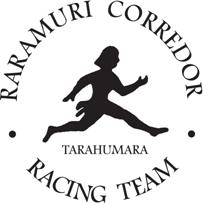
1992 -
1998
Tarahumara Racing
Team and the Apache Running Warrior Geronimo
Native American
Running History
by
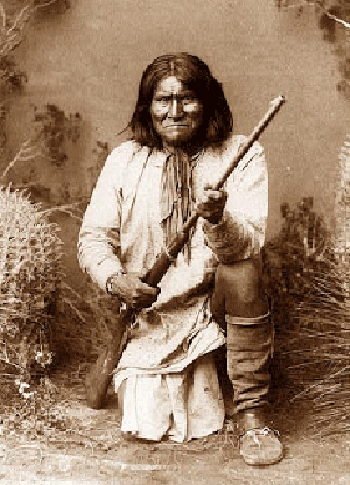
Geronimo, a
Chiricahua Apache was the leader of the great running Apache
warriors.
Native American spirituality - Awantar - a test of endurance in life and running
Awantar - to endure
whatever adversity life throws in your path. This is the motto of the Tarahumara
Racing Team. All of the participants in the Tarahumara Racing Team are alive as
of 2013 and thriving, they have endured. In 1992, a medical study said that some
of them had heart damage from that Leadville race. I felt that it was stress
brought on by the medical testing procedures themselves not from the race.
History has now proven that I was right. Awantar is a concept of virtually all
Native American philosophy and religion, especially applying to their running
culture. The traditional native Tarahumara races that I have been involved in,
are an endurance test “Awantar,” almost to the death being over 150 miles long
and lasting more than 24 hours, in some cases.
Geronimo and all of
the Tarahumara runners and sponsors had something in common. One was, they had
plenty of “Awantar”.
The first
Tarahumara champion racing team in Leadville Colorado 1993. Victoriano Churro
(2nd from right) was then and still is today the oldest winner at age
55 in Ultra Marathon running. Benjamin Nava (3rd from left),
age 20, was the youngest finisher in Ultra Running history at that time.
Carrildo Chacarito was 2nd place (3rd from right). Manuel
Luna (far right) was 5th place finisher. Also pictured is Antonio
Palma and Felipe Torrez from the Batopilas Canyon. Bottom row left to right is
Kitty Williams, Patrocinio Lopez and Richard D. Fisher Tri-Team Captains and
coaches. A very proud moment for the Tarahumara people and their coaches.
This team eventually went on to have more than 50 International participants,
1992-1998. The team record - Winning 7 of 11 and setting records in
3. These are the only objective times, distances and terrain ever measured.
From these performances, we now have a ruler from which to judge the historical
record on the Apache, the Anasazi, and other famous Native American tribes.
Surely, people who were running for their lives could move at this kind of pace
through similar terrain all over North and South America. It is a know
historical fact, in terms of long distance endurance, that the Native Americans
could out run and out last horses which the Apaches were specifically known to
do.
We know from the
Tarahumara legacy of the 1990s that these Apache running warriors could run from
the south end of the Chiricahua Mountains to “Campo Apache” in the Sierra el
Tigre, a distance of approximately 80-100 miles of very rugged canyon country in
less than 20 hours. Photo taken in the 1880s.
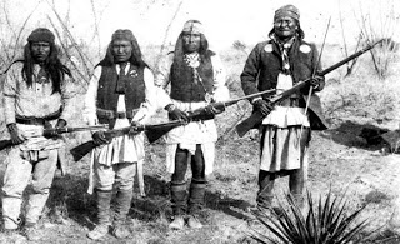
The only
photographs every published of the Campo Apache in the Sierra el Tigre were
printed in the Journal of Arizona History Vol. 27 No. 1, “Geronimo’s Hideouts in
Mexico” 1986 by Richard D. Fisher.
Although I have
since published many guide books, maps and magazine stories, selling hundreds of
thousands copies, as well as sponsored the only ever in history
International Championship Tarahumara Racing Team, I
never revealed the locations of their hidden re-doubts.
Like the Tarahumara and the Apache before them, I never came to fully trust the
white man. As the years came to show, my concerns were well
founded, but that is another story altogether and better told another
time.
After
the success of the Tarahumara Racing Team, some found our hidden
lands, but had little success with their
runners
Internationally or
in using these reticent people for modern commercial sports “circus
circus.”
In the early
1990's I found that the Tarahumara Racing game with the ball had
become extinct for about a decade as the
hidden villages would not participate with
the Indians living along the roads any longer. In fact, they
spoke a different dialect and did not like to converse with the
“modernized” Tarahumara.
Since the Apache,
and the Anazazi before them, lived in hidden in remote canyons and had to
run and carry heavy burdens of
food
and blankets and cooking pots, I was keenly interested to know exactly how
fast and how far these Running Tarahumaras
could actually
race. I was to find out in a very weird and
rather extreme way.
An Ultra Runner,
Kitty Williams, approached me about doing something with my long term
relationship with the Tarahumara.
I first just said
"no, history shows the white man and the Indian have a very long and bitter
history. The Indian always loose and in fact, for the most part, the natives
just die out...”
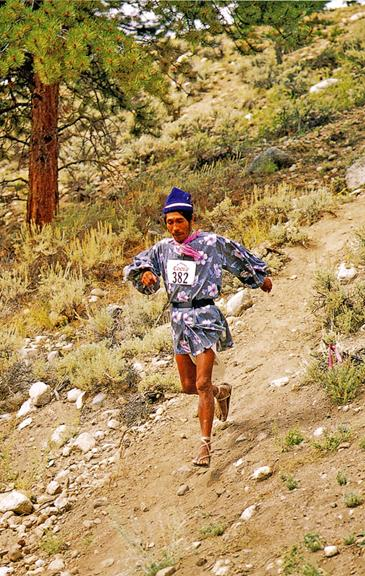
Victoriano Churro,
the oldest winner in the history of ultra-marathon running and first ever
Tarahumara Racing Champion 1993.
His winning time 20:03:33
From PBS (for the complete
story see link below)
Narrator: In 1886, in the
blazing summer heat, 39 Apaches raced across the desert southwest, chased
by 5,000 American soldiers. They were the only Indian people in the entire
nation still fighting the U.S. Army. For many months, the handful of men, women
and children, evaded capture—running, running, then running some more, as much
as 80 miles a day. Across the nation, Americans were horrified by details of the
chase—some real, many exaggerated.
Thirty-nine people
were on the run that summer, but the soldiers were really after only one man. To
his hunters he was a vicious killer, capable of murdering without mercy. To the
Apaches he was more complex—courageous yet vengeful, an unyielding protector of
his family’s freedom, yet the cause of his people’s greatest suffering. In the
course of the chase and in the years that followed, he would become a legend and
the symbol of the untamed freedom of the American West. His name was
Geronimo.
Ellyn
Bigrope: Long ago Coyote
opened a bag of darkness and it spread over the world. Creatures of the night
loved it. But birds and little animals longed for day. The little animals played
a game to win back the light. They won, but one night monster remained. After
the game, the first human, White Painted Woman, gave birth to a son. She hid him
from the monster. When the boy was grown, he faced the monster and killed it. He
was then called Apache—all Chiricahuas are named after
him.
Narrator: Geronimo was born
sometime in the 1820s at the headwaters of the Gila River along the border of
what became Arizona and New Mexico.
Jennie Henry,
Cibecue Apache: His name is
Goyaalé. We also call him Geronimo. He might have had other names too. A long
time ago people used many names.
Narrator: As young as age
six Geronimo learned to hunt. He would have spent hours crawling along the
ground sneaking up on prey, catching birds with his bare hands. When he made his
first kill he swallowed the animal’s heart raw and whole to insure a life of
success on the chase.
Oliver Enjady,
Chiricahua Apache: Young kids grow up
dodging arrows, dodging rocks. They were taught to use the bow and arrow very
early. They were taught to run and run and run as young ones. And then as
they grew older, they depended on this.
Narrator: “No one is your
friend,” Geronimo was told, but your legs, your legs are your
friends.
Tim Harjo,
Chiricahua Apache: There was always
danger. There was always that fear, that just around the corner somebody would
be coming across it to take your life.
Being
on the run certainly defined Geronimo's way of life. He belonged to the smallest
band within the Chiricahua tribe, the Bedonkohe. Numbering a little more than
8,000, the Apaches were surrounded by enemies—not just Mexicans, but also other
tribes, including the Navajo and Comanches.
Raiding
their neighbors was also a part of the Apache life. In response the Mexican
government put a bounty on Apache scalps, offering as much as $25 for a child's
scalp. But this did little to deter Geronimo and his people. At the age of 17
Geronimo had already led four successful raiding
operations.
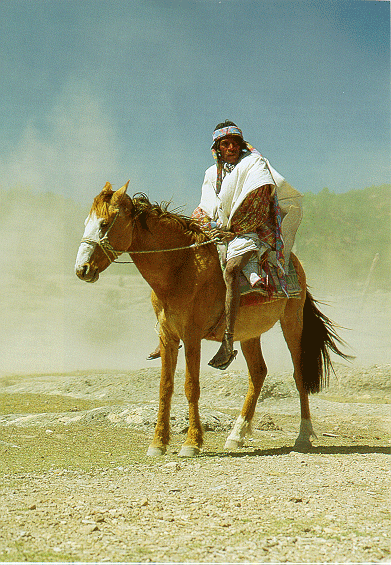
The last of the
Apache-Tarahumara horsemen from Choguita-Narnarachi region of the Copper Canyon
of Chihuahua Mexico. April 1994
They have now, by
2013, completely died out and are now an extinct sub-tribe as is their special
language and culture.

I published a book
that sold more than 10,000 copies on the connection between the Anasazi and the
Ancient Knowledge of the Tarahumara and Apache Indians of today. Running,
ancient agriculture, religious beliefs and load carrying are the main
connections between these ancient Anasazi clans and modern yet traditional
tribes. This is the front cover collage from 2003.
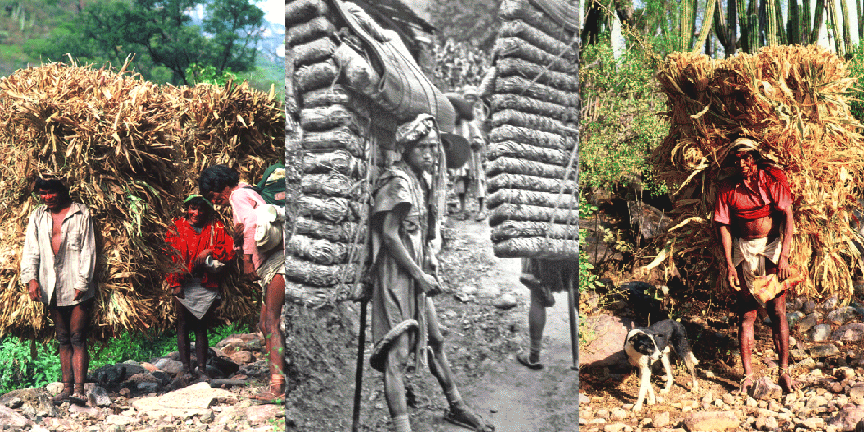
I have documented
Tarahumara Indians transporting loads of over 150 lbs for dozens of miles in
exceedingly rugged terrain in the Copper Canyon.
Tibetan tea porters have
been documented by the Royal Geographic Society carrying up to 325 lbs, 5 miles
per day for one Mexican silver dollar, in the 1890s. These are the heaviest
loads that we have been able to find historical documentation for. This load
carrying capacity has tremendous validity when attempting to understand what the
Chaco Canyon Anasazi were carrying in the time period of 829-1159 CE.
This
is one of the three primary reasons in my personal and professional interest
concerning the Tarahumara Racing Team’s performance.

During the 1990s
the Tarahumara region was extensively deforested which caused immediate
micro-climate change and an intense drought set in.
Through my relationship
with the Tarahumara Racing Team, I found out the impact on the Tarahumara
people, as thousands of children starved to death during that decade. My
personal effort, which continues into 2013, is to deliver over 200 tons of
appropriate foods.

American family to
Tarahumara families. We all had some great adventures 2002-2011. Copper
and Batopilas canyons, fabulous eco-tourism and cultural adventure
destinations.
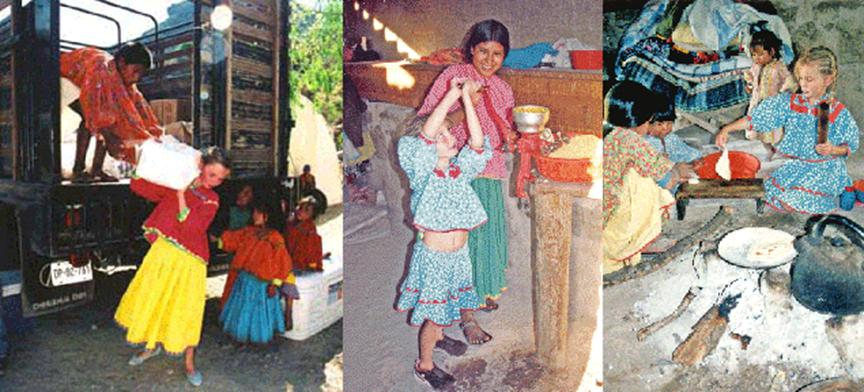
Learning and
enjoying traditional Tarahumara lifeways during the famine relief
expeditions.
The winning history
for Native American running is confined to Jim Thorpe 1912, Billy Mills
1964,
and the Tarahumara
Racing Team 1992-1998.
Why?
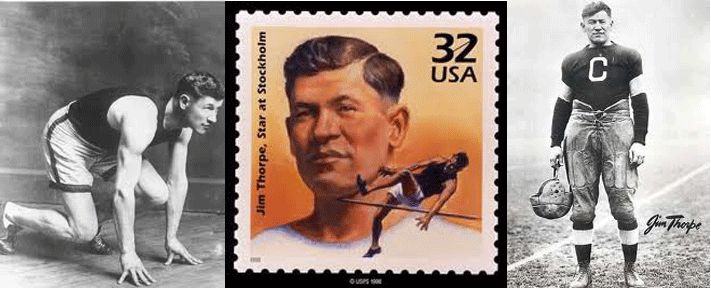
Jim
Thorpe was perhaps the United States' greatest athlete of the twentieth century,
an American Indian, Thorpe was born in 1888,was also known as Wa-tho-huck, which
in the Sac and Fox language means "Bright Path." He indeed followed one of the
brightest paths in United States athletic history, excelling in football,
baseball, and Olympics competition. He was selected by the Associated Press as
the greatest athlete of the first half of the twentieth century.
As was the custom
of the day, the medals were presented to the athletes during the closing
ceremonies of the games. Along with the two gold medals, Thorpe also received
two challenge prizes, which were donated by King Gustav V of
Sweden for the decathlon and Czar Nicholas II of
Russia for the pentathlon. Several sources recount that, when
awarding Thorpe his prize, King Gustav said, "You, sir, are the greatest athlete
in the world", to which Thorpe replied, "Thanks, King".[19][20]
In
1982, the International Olympic Committee finally recognized Jim Thorpe as the (co)winner of the 1912 pentathlon and decathlon. In 2000 a
majority of respondents to an ABC Wide World of Sports internet poll did vote
for Thorpe as the twentieth century's greatest athlete, and the results were
announced prior to Super Bowl XXXIV.
William Mervin
"Billy" Mills, also known as Makata Taka Hela (born June 30,
1938), is the second Native
American to win an Olympic gold
medal.[1] He
accomplished this feat in the 10,000
meter run at the 1964 Tokyo Olympics.
His 1964 victory is considered one of the greatest of Olympic upsets.[2] A
former United States
Marine, Billy Mills is a member of the
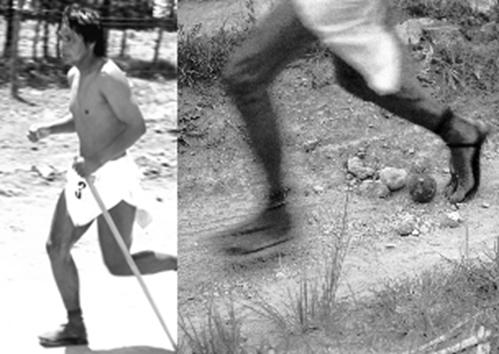
While the
Tarahumaras run in very minimal sandals, they would think anyone who ran
barefoot in their terrain was a fool.
Running
Feet
Art
Beauregard
Ultra Marathon Running - Term Paper
12/96
(Note: Apparently
Mr. Beauregard made no effort to fact check or contact the sponsors of the
Tarahumara Racing Team easily available at that time in 1996. An otherwise
excellent effort by Art Beuregard and mostly factual with my corrections noted in red. (We very much want to thank Art Beauregard for his
fine efforts and this opportunity to demonstrate the problem in accurate media
reporting facing the Tarahumara Community today, especially since
2009.)
Art
Beauregard Ultra
Marathon Running -
Term Paper 12/96. For the people to whom running is
a lifestyle, ultra marathon running seems
an old phenomenon, ... The Tarahumara routinely run distances
only covered by only the most advanced ...
Tarahumara public
racing began at the 1928 Olympic marathon. The two Indians that were running
were not aware of the distance and when they finished, they were not tired and
said, "Too short! Too short!" (Lutz 22) correct
The Tarahumara
first appeared on the Ultramarathon circuit in 1992 at the Leadville 100-mile
run in Colorado. They were brought from Mexico and funded while they were here
by Rick Fisher, operator of Wilderness Research Expeditions (Ramos A1). Richard D. Fisher is disliked in the Ultra
community because he is thought to be loud, outspoken, and rude. For the Tarahumara, this is true concerning the Ultra
Runners themselves. Many of the Ultra Runners are big at back slapping, hard
handshaking, hugging, jumping around and ho-ra-ra shouting, a well
known and observable fact which is objectionable to the Tarahumara. As
white Americans are so much bigger and more aggressive than the
Tarahumaras, they find these behaviors extremely offensive and in
fact, frightful. They do not like to be touched or given
hard handshakes which white people love to do. The Tarahumaras, in
fact, do not like to be touched at all, something not respected nor understood
to this day. So the attempt made to educate the white runners and race officials
was turned around and blamed on the sponsor, Richard D. Fisher for their own
behavior. Fisher tried his best to educate about this to no avail. To flip the
blame is very common and human thing to do, but none the less, harmful to
cultural understanding and respect for others as well as truth telling in
journalism.
Richard
D. Fisher, as leader of the team, by necessity is very quiet, reserved and must
stay busy caring for the 6-10 runners and a dozen crew members. The only
solution was to begin isolating the runners after 1993. A well meaning 200 pound
white runner pounding a 125 pound Tarahumara runner on the back was not only
objectionable, it was rude and insulting. These Tarahumara might be
champions but they could actually be injured by these poundings, extra hard
handshakes and bear hugging which even entails lifting them off the
ground. These white guys would say “Oh, sorry, I was just
trying to be friendly” but in fact if, nothing else, they were
demonstrating dominance in the crudest sense of the word and, yes they meant it
that way, in many cases. As a result, I and in later years, Mr. True Hickman,
felt it was too dangerous, or at least, too uncomfortable to bring them out
Internationally after 1997.
It is also believed
that he uses the plight of the Tarahumara simply to gain attention for himself
and for his organization. Yes, this is the view
point and position of the white ultra running community right from the very
beginning. Yes, absolutely true! I tried at every turn and opportunity to
draw attention to the massive deforestation going on in the Copper Canyon at
that time and the devastating famine that was just beginning. Still to this day,
there is no understanding, by virtually anyone associate with racing or
otherwise, how poor the Tarahumara truly are, as well as how things are
degrading their incredible culture, step by giant step, year by year. The
Race Directors want their entry fee money months in advance, the media wants
their time and their spin on their culture and running events, as well as
everyone else wants their cut out of them.
But
this is obviously not the view of the Tarahumara Racing Team members
themselves, as they continued to come with me time after time. This
is the strategy of the culture of conquest...neutralize the
leaders, in this case me. No Fisher and no Tarahumara international running
champions and winners, true. Also never recognized is that it cost about $1,000
USD
Per
runner to bring them to an international event. We brought a minimum of 5 and
sometimes a many as a dozen. And thousands more if they won, of course. No one
associate with racing every asked nor contributed. Round figures it was in
excess of $100,000 thousand dollars over 6 years in question for just the
racing. Adding food deliveries over 15+ years it is easily over $175,000 USD.
Easy as well free to criticize but as real challenge to put your money where
your mouth is friends.
In their first
race, none of the Tarahumara finished. In 1993, Fisher tried again but this time
he familiarized the indians with the course, the equipment and the American
racing customs . In 1992 the Tarahumara had many problems. First, they were
unfamiliar with the course. Second, they did not know how to use the equipment.
At night, they ran with their flashlights pointing up likes the torches that
they are used to. Not true, just a stupid
comment that is repeated time and again. This first effort ended about
12 noon so no need for flashlights. The Tarahumara have owned and know
how to use flashlights for decades. Third, at aid stations they simply
stood there and therefore received little nutrition and became weak and
dehydrated. In their culture is not polite just to take food. They wait until it
is offered. True
In the 1993
Leadville they fared much better. Tarahumaras took first, second and fifth place
(Williams 8). The most amazing thing about the Indians was their pace. The
winner was fifty-five years old and only ran the second half of the race twenty
minutes slower than he ran the first! Another thing that shocks the ultra
spectators is Tarahumara footwear. They wear sandals called huaraches made out
of old tire tread and leather straps. A Tarahumara won Leadville again in
1994.
Later that same
year (actually September 1995) in Utah at
the Wasatch 100-Mile run, the Tarahumara were part of a controversy. Someone did
not pay their entry fees so they weren't allowed be official runners. They ran
unofficially and a Tarahumara was the first to cross the finish line. The Tarahumara runner Gabriel Bautista set the
course record at that time. This greatly upset race officials (yes, it did) and the second person (standard issue Ultra runner) to cross the finish
line had to be declared the official winner. This
is very similar to the Jim Thorpe tragedy that happened after the 1912 Olympics
where he was stripped of his medals.
What
actually happened here?
1.
The race director would not allow the entry payment in the name
of "Tarahumara." Several months in advance the team sponsors had no idea
which individual Tarahumara would attend.
2.
Even though the race director knew the
Tarahumara had absolutely no money he would not waive
the entry fee until race day. Or if he was a good person, he could have
waived the entry fee altogether.
3.
Even when it was reported on the front page feature page of "The Salt Lake City
Tribune" September 5th 1995 and covered by "NBC - Nightly News by Tom Brokaw,
the race director "hardened his heart against the Indian Runners" and
would not allow them to make late entry payments which were donated by
the kind hearted people of Utah who wanted to see the Tarahumaras
run.
In a fine effort by
Art Beuregard the historical problem for the Tarahumara running is documented
above with corrections with corrections. In this example, he is telling only one
side of the story. This has happened in all known media accounts since
2004. It is hoped that with the correction the reader can see the different
points of view, why the controversy, and the challenges faced by
Tarahumara runners and their sponsors in a balance and thoughtful
way.
This little example
of no fact checking with sources, even in
1996, illustrates the problem especially with reports made after 2008,
more than a decade after the events occurred. There are
blowhards, bullies, hangers on, swindlers, wannabes in every field and
major event such as this one about the Tarahumara Racing Team and the Legendary
Tarahumara Runners. These current fakes glom onto the Tarahumara’s success
without knowing not a thing about the Tarahumara Racing Team, just miss
reporting of 2nd and 3rd hand reports more than a decade later, that were
never fact checked in the beginning. In the media and especially Hollywood such
scams are common place.
These BS artist
were labeled straining to be "Gonzo and overly clever" by Dan Zak of the
Washing Post (June 21, 2009). Good call Dan Jak. Current postings on the
internet have been recorded to say "will Hollywood ruin" the
Tarahumara racing story? Given events and personalities post
2004, that had no direct experience with a Tarahumara Champion Runners, and the
poor quality journalism currently in vogue, the Hollywood Version
probably will be as the ol' rancher was fond of saying, "bull pucky", "horse
shit" and "hog wash." hahaha-ah
Life is often so,
so funny, even when it is a tragedy.
The History Since
1997
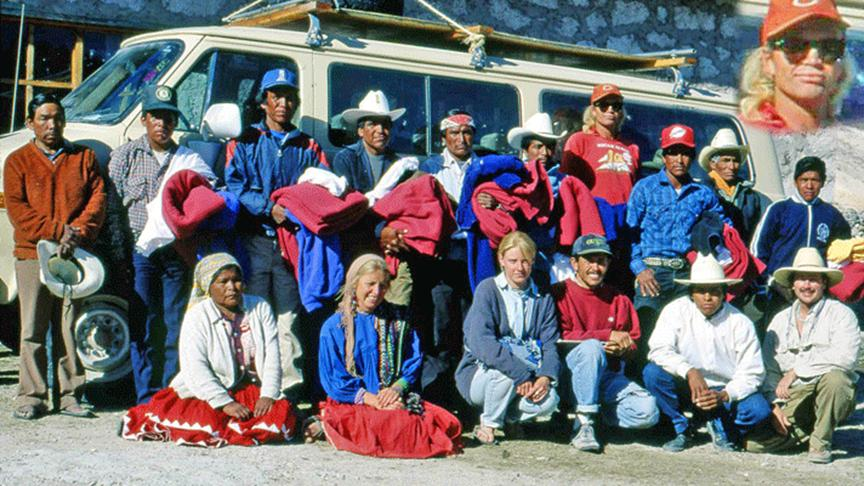
True Hickman Shaggy
spirit.
Born Michael
Randall Hickman, he had many stage names over the years. Micah True, Caballo
Blanco (White Horse), Gypsy Cowboy, Shaggy, and a number of other ones. His true
spirit was with the Native American people and he was very against any type of
commercialization of running, in general and the exploitation of the
Tarahumara9OR (or himself) by any form of the media or sports marketing.
Sometime after 2009, drastically altering his appearance he shaved his head,
losing his long hair which he had had for the previous 35 years or more. Near
the time of his unfortunate and untimely death, via email he expressed strongly
his dissatisfaction with the commercial marketing campaign that had take over
his life. Mr. Micah Hickman True passed away in a remote canyon in the Gila
Wilderness in March 27, 2012. Perhaps he died of a broken
heart?
Under the
name Micah True he participated in our programs a number of times in the
1990s. Here he is pictured at one of our races in 1995 near Creel Chihuahua.
After 2000 True Hickman tried his best to sponsor races for the Tarahumaras and
in 2005- 2008 finally obtained enough funding to setup a race in Urique.
Ultimately this race turned out to be very successful as the Tarahumaras would
really like to race again. Mr. Hickman was against bringing them to the
international circuit because he was well aware and involved with some of the
unfortunate events prior to 1998.
In his last major
posting Mr. Hickman said,” I want to be remembered as authentic.” There may be
something important and especially meaningful in the timing of this statement,
or why would he post such a thing? Why was he interested in “how he would be
remembered” at the moment of his greatest
success?
None the less we
will remember “Shaggy” as being “authentic in the time period that we knew him
in the 1990’s
May Micha True
Hickman’s long haired legacy of Native American loving and
respecting spirit rest in peace.

The Easter
ceremonies were spectacular events back in the ‘90s and perhaps are still
today.

Richard D. Fisher
on famine relief deliveries 1992-2011 (above and
below).


Pictured above is
the drought devastated landscape, a starving Tarahumara Child at the Tarahumara
Children’s Hospital in Creel which we supported with tens of thousands of
dollars in direct cash donations over many years and the happy Tarahumara
children and families during a famine relief food
delivery.
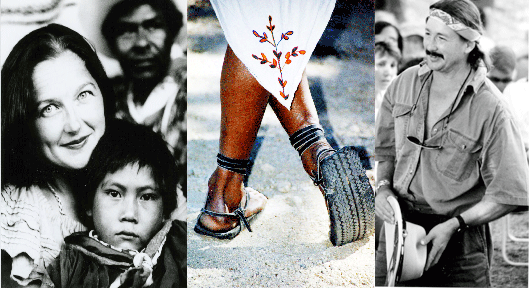
Kitty ‘Kit’
Williams, the person who first came up with the idea for helping the
Tarahumaras with and involving ultra-running.
And the “glue” (running feet)
that made it all happen for Richard D. Fisher and of the last legendary
Tarahumara racers. 1990-1998
Kitty “Kit”
Williams tried her very best again and again for the Tarahumara Racers and she
took a lot of cruel and undeserved hits for it as
well.
She wrote the first
“Born to Run” book. A master piece, which was not represented ethically by an
agent, I believe. Much of her fine writing was taken and spun into other
media projects several times over the years. She deserves so much credit and
honor for what she has done for the Tarahumara over two
decades.
I must say she is a
beautiful, brave, kind hearted, compassionate and enduring human being who
deserves the highest admiration and respect.
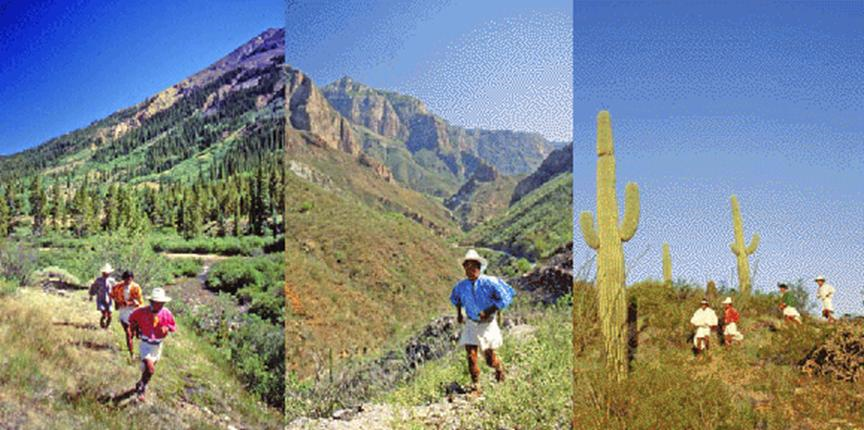
During the 1990’s
several Tarahumara told me that they would prefer they raced until no one was
left standing, after they had finished in the top 10 of a 100 mile Ultra. They
simply said we are “not tired.” In the mid-90’s we even developed a youth team
of boys in the 12 year old range that could win anywhere anytime at any
distance from 10KM to 50 miles. By then however, I was starting to get concerned
about safety and security for our team. It seemed that the youth team might not
be a good idea. Too bad, because by now the Tarahumara might have been
competitive in the Olympics representing Mexico in the
Marathon.
It should be
pointed out that the Tarahumara Racing Team was always underfunded and this
greatly contributed to our very sadly closing down the team in 1998. Micha
Hickman True also suffered the same problems. He tried to set up his own
races starting in 1995 but was not successful until 2005 when he eventually
compromised his policy of who could sponsor his races. While there are many
emails and published accounts that he was not happy with the sponsorship
affiliations, it was the sponsorship money that allowed him to try the racing
game. There were many signs that he was troubled and unhappy but as of now we
have none of the factual details. Therefore we have ideas of the problems as
they also happened to us back in the ’90 but will not speculate here at this
time. We can only look at his published emails and Facebook entries to see a
glimmer of what he was going through at the time of his death.
Articles published
during the time period of the actual performance of the Tarahumara Racing Team
and most those who were there with the Tarahumara Champions would agree, for the
most part, are accurate.
2002: Newsweek
International, “Running On
Empty.” Feature review of Tarahumara running. August.
2001: Explore Magazine, "Mexico's Copper
Canyon."
2000: Ambassadair's Journey, "Mexico's Copper
Canyon."
Escape Magazine, "South by Southwest." Mexico's Copper Canyon
photo feature.
1995: Esquire, “Born To Run.” British Esquire.
November.
People Magazine, “Going the Distance Mexico’s...Tarahumara Run
Ultra-marathons for Tribal Survival.” October.
1994: Native Peoples, “The Return of the
Tarahumara.” Cover story.Front cover photo. Spring.
1993: Summit Magazine, “Copper Canyon.” Winter.
Runner’s World, “The Legend of the Tarahumara.” Feature article and photographs. December.
Running Wild, “A Visit to Copper Canyon.” Summer.
1991: Family Magazine, “Copper Canyon.” August.
1990: American Way, “Conquering the Canyons.” July.
Buzzworm, “Sierra de Tarahumara - Exploring the Lost Canyons of
Mexico.” June.
Arizona Highways, “Barranca del Cobre - Mexico’s Grand Canyon.” January.
1989: Native Peoples, “Semana Santa - A
Celebration.” Cover story. Front cover photo. Summer.
1987: Backpacker, “Mexico’s Copper Canyon - Endless
Summer Just South of the Border.” November.
1986: Journal of Arizona History, Vol. 27, No. 1, “Geronimo’s Hideouts in Mexico.”
1985: Arizona - The Arizona Republic Magazine, “Mexico.” April.
Newspaper Articles
- Partial List
2000-2001: Austin American - Statesman, Tucson
Citizen, Sun - News, Alpine Avalanche, "Tarahumara
Famine"
1998: Arizona Daily Sun, “Dancing for Their Lives.” Tarahumara Indians article. February.
1989: El Dia, “Virgin of Guadalupe.” Color
article, Spanish newspaper, Houston, Texas. December 31.
1997: Arizona Republic, “Mexico’s Copper
Canyon.” Full page color article. June 1.
Four Corners Magazine, “Tarahumara Indians.” Cover and feature
article. April/May.
Flagstaff Daily Star, “Sad Songs of Drought.” Front page feature article. February 3.
1996: Los Angeles Times, “Tarahumara
Runners.” Front page feature article. September 25.
Taos Daily News, “Tarahumara Indians Run for their Lives.” July
15.
1995: The Salt Lake Tribune, “Tarahumara
Runners.” Front page feature article. September 5.
1990-1995: Over 28 major feature articles nationwide including
the New York Times.
1989: Milwaukee Journal, “Mexico’s Copper
Canyon.” December 31.
The Dallas Morning News, “Mexico’s Copper Canyon.” November
19.
The Oregonian, “Mexico’s Copper Canyon.” November
15.
The Tampa Tribune, “Mexico’s Copper Canyon.” October
15.
The Tucson Citizen, “Backs to the Wall.” January
31.
1988: Vanguardin, “Un Trotomundos.” Cultura. September 10.
1986: The Tucson Citizen, “Three Tucsonans
Explore Remote Mexican Barrancas.” February.
1985: The Tucson Citizen, “Mexico - Fisher’s
new book guide to wild places.” February 1.
1983: The Tucson Citizen, “Desert Museum Photo
Contest - First Place Award Wildlife.” Focus. August
30.
Fort Apache Scout, “Cibecue Race.” April 15.
Television
1995: Qantas Airline TV Commercial, “Best in the
World.” Tarahumara running. November.
NBC, “Nightly News with Tom Brokaw.” Tarahumara in Utah.
September.
PBS, “Arizona Illustrated .” Tarahumara Arts and Crafts, Famine
Relief. February.
1994: CBS, “Eye on Sports.” Tarahumara record breaking win in Leadville
Trail 100. October.
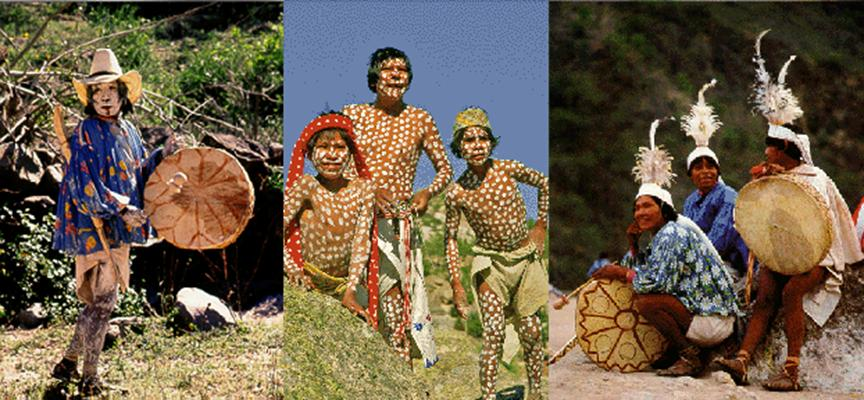
Tarahumara culture
is a deeply felt and revered Native American lifeway in which many aspects go
back a thousand years or more.
“Modern” religious ceremonies from the 1600s
are pictured above.

Copper Canyon,
Batopilas Canyon and the Sierra Tarahumara as well as Basaseasachic Falls
are some of the greatest splendors of the Sierra Madre in Northern
Mexico.
The Copper Canyon
Train is the gateway to the entire unbelievably spectacular region.
Here is
available to international tourists an unsurpassed adventure destination. Truly
a wonder of the natural and cultural world.
As their primary
coach and primary sponsor I am proud to say I “fought” for the rights of our
great Tarahumara Runners. Absolutely, I am temperamental and fiercely protective
of those I am responsible for. I will also note that in the commercial sports
world I am relatively mild mannered as compared to well known temperamental
coaches and players of the era as well.
Like Geronimo, who
I have always admired and studied, I waged my battles and never gave up striving
for equal rights for
Native American
athletes and respect for our Winning Tarahumara Racing Team
members!
The first and
second ever Tarahumara Champion Runners were honored by Governors as well as the
President of Mexico.
If the Racing Team
had been funded in any way on the American or Mexican side of the borders,
perhaps our youth team of 2005 would have by now been representing Mexico at the
Olympics for the Marathon Distance and competitive with the Ethiopians who have
a National running development program.
Native Americans
are well known to be great endurance runners. Why in a century, have only
two Olympians and a handful of Tarahumara Indian Champions stopped participating
internationally after such an unprecedented success? With several different
coaches and sponsors why are there no more international champions after
1997? THE questions remains Why?
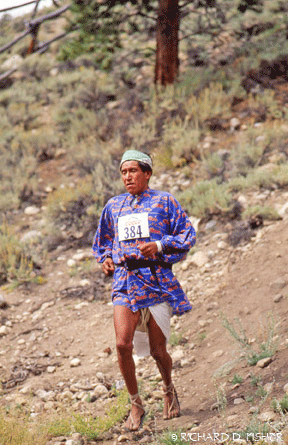
LAST STAND OF THE
GREAT TARAHUMARA INTERNATIONAL RUNNERS 1997
Great Native
American Champion, Carrildo Chacarito.
First Place, Age 43, Angeles Crest 100M,
Sept 27, 1997.
Carrildo was
2nd place finisher overall at the Leadville 100 in 1993 and at last
was able to prove his championship abilities in 1997.
He was the last
Tarahumara international champion.
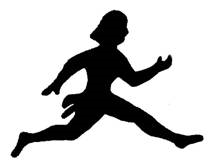
http://www.people.com/people/archive/article/0,,20101974,00.html
http://en.wikipedia.org/wiki/Geronimo
http://www.pbs.org/wgbh/amex/weshallremain/files/transcripts/WeShallRemain_4_transcript.pdf
http://www.nps.gov/nr/travel/amsw/sw12.HTM
http://www.nps.gov/nr/travel/amsw/sw28.htm
http://www.canyonsworldwide.com/canyonlovers/richard-fisher/index.html
http://www.canyonsworldwide.com/canyonlovers/canyons/slide-1/index.html
http://www.canyonsworldwide.com/canyonlovers/canyons/what-goes-around-comes-around/index.html
http://en.wikipedia.org/wiki/Battle_of_Cibecue_Creek
http://www.lehigh.edu/~dmd1/art.html
http://en.wikipedia.org/wiki/Billy_Mills
http://en.wikipedia.org/wiki/Jim_Thorpe